Manuscripts Etc.
| CLOSE WINDOW |

|
The following items are drawn from the William Faulkner Foundation Collection at the University of Virginia's Albert and Shirley Small Special Collections Library (http://small.library.virginia.edu/). |
|
Faulkner regularly called The Sound and the Fury his own favorite among his novels. It was the book, he told several audiences at the University of Virginia, "that I anguished the most over, that I worked the hardest at" (13 March 1957; also 15 April, 25 April, 25 May, etc.). The surviving manuscript, partial typescript and later complete typescript document that work. The record is incomplete — it seems certain that Faulkner composed earlier drafts before the extant manuscript and that he made a last set of revisions on the lost galley proofs — but what we do have confirms Faulkner's claim about working hard to get the novel right, or as he also frequently said, to make it his "most splendid failure" (15 April 1957).
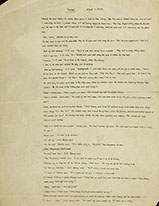 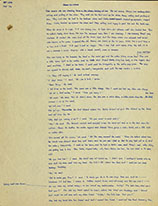  The page below left is the way Quentin's section begins in one of the more puzzling documents in the Faulkner Collection: 24 pages of a "ribbon typescript" that has been copy-edited by at least two people other than Faulkner. The scholarly consensus is that this typescript represents what Faulkner sent to New York for his publisher to use as the setting copy for the novel, but then replaced after making extensive revisions in Quentin's section before the novel was set in print. It largely follows the manuscript version above right.
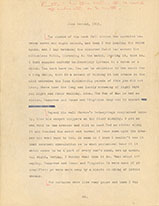  Below: the next 3 pages of Quentin's section, from the copy-edited ribbon typescript. "Father said" does appear on the third of these pages (below right). The original beginning of the section — "one minute she was standing in the door" — puts in a brief appearance on that same page; it's not clear who crossed it out using a pen, but it probably wasn't Faulkner. On the first page below, it's shocking to see how one of the copy-editors, red pencil in hand, felt free to "improve" Faulkner's text, by clarifying the dialogue and even deleting one of Quentin's more elliptical fragments of memory.
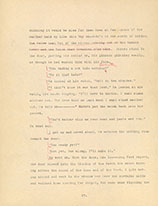 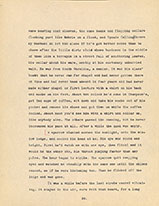 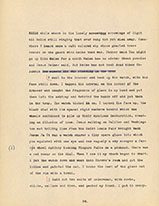 The manuscript pages below provide other windows into the pattern of Faulkner's revisions. Note, first, that he is writing on two different kinds of paper, one of several indications that there was at least one earlier handwritten version of the novel prior to the one that we have.
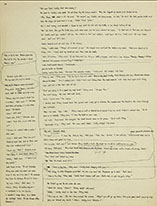 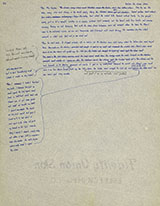 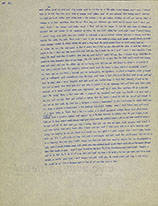 Another pattern that these pages make visible is Faulkner's increasing interest in representing the African American characters who live largely at the margins of the Compson family's life. The six pages below describe the narrative's first engagement with black life: after watching the white men play golf, Luster takes Benjy to the branch where the black women are washing clothes, probably for paying white customers. The first page is from the manuscript, and includes the moment when Benjy remembers Caddy getting her underwear muddy. But also noteworthy is the way Faulkner's marginal addition stages an encounter between white and black worlds.
 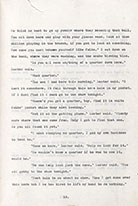  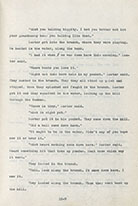 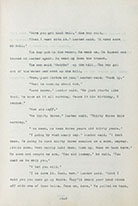 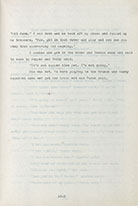 In the edition of The Sound and the Fury manuscripts that Noel Polk prepared for Garland Publishing, he points out that even as he re-typed the novel for the last time Faulkner continued to experiment with ways to deploy the conventions of English grammar to represent the idiosyncrasies of Benjy's mind. In the first part of Benjy's section the dialogue is punctuated according to standard usage rules (below left). Then for a few pages Faulkner left out all punctuation inside the quotation marks (below center). Beginning on page 51 (below right) he found and settled on the method that we see throughout Benjy's section in the published text: using periods, even when a comma or a question mark is called for. 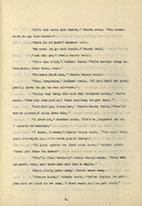 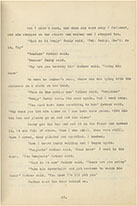 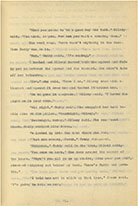 From the available evidence, it seems that Faulkner had less trouble finding the right ending for the novel than the right beginning for Quentin's section, but it is still interesting to see him "working at" that quest even through the final typescript. Below left and center: the often heavily revised manuscript versions of the ending. Below right: the typescript version, where after a few final changes he decided he had put the words into their ordered place. The handwritten place and date obviously were another afterthought, a Joycean touch. Faulkner apparently finished this typewritten version at his friend Ben Wasson's apartment about half a year after writing the first page of the manuscript, but given how many differences there are between this typescript and the published text, this isn't the real end of the story of the book's composition. Perhaps someday someone will find the galley proofs on which all the evidence suggests that Faulkner himself continued to work at the novel until the last possible moment.
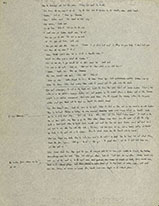  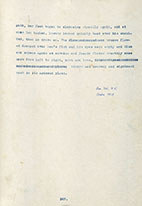 If you want to learn more about what scholars have had to say about the composition, revision and publication of The Sound and the Fury|, five good places to start are: James B. Meriwether, "Notes on the Textual History of The Sound and the Fury," 1962, revised and reprinted in The Merrill Studies in "The Sound and the Fury," ed. Meriwether (Columbus: Merrill, 1970): 1-32; Emily K. Izsak, "The Manuscript of The Sound and the Fury: The Revisions in the First Section," Studies in Bibliography 20 (1967): 189-202; Gail M. Morrison, "The Composition of The Sound and the Fury," in William Faulkner's "The Sound and the Fury": A Critical Casebook, ed. Andre Bleikasten (New York: Garland, 1982): 33-64; Noel Polk, An Editorial Handbook for William Faulkner's "The Sound and the Fury" (New York: Garland, 1985); Polk, "Introduction" to William Faulkner Manuscripts 6: The Sound and the Fury I (New York: Garland, 1987): vii-xiii. Citing this source: |
